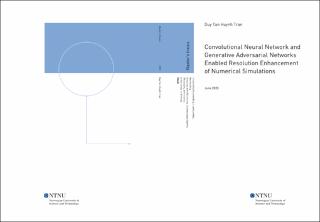| dc.contributor.advisor | Rasheed, Adil | |
| dc.contributor.author | Tran, Duy Tan Huynh | |
| dc.date.accessioned | 2021-09-23T18:03:27Z | |
| dc.date.available | 2021-09-23T18:03:27Z | |
| dc.date.issued | 2020 | |
| dc.identifier | no.ntnu:inspera:56990118:20927171 | |
| dc.identifier.uri | https://hdl.handle.net/11250/2780895 | |
| dc.description.abstract | Optimal vindmølleplassering og prognoser av vindmøllers kraftproduksjon krever nøyaktig kunnskap om vindfeltet. Generelt blir målekampanjer foretatt for å innhente informasjon om de rådende vindforholdene i et bestemt område. Disse målekampanjene er ofte kostbare, og gir vinddata med meget grove oppløsninger. Et attraktivt alternativ til målekampanjene er numeriske simuleringer, men de er begrenset av stor regnetid.
Vi presenterer en løsning gjennom en innovativ kombinasjon av tradisjonelle numeriske løsere (numerisk fluiddynamikk kode) og avanserte maskinlæringsalgoritmer som Convolutional Neural Networks (CNNs) og Generative Adversarial Networks (GANs). En tradisjonell numerisk løser basert på bevaringslovene til masse og bevegelsesmengde brukes til å generere et grovt vindfelt, og deretter brukes maskinlæringsmodellene til å forfine oppløsningen. Til slutt presenterer vi eksperimentelle resultater som reflekterer muligheten til å forfine oppløsningen til et vindfelt og rekonstruere det originale vindfeltet ved bruk av maskinlæringsalgoritmene. Det er ikke blitt gjort funn av tidligere presenterte løsninger som rekonstruerer høyoppløste vindfelt i et ekte komplekst terreng. | |
| dc.description.abstract | Fluid flows, like atmospheric flows around terrains in wind farms, are governed by a broad variety of spatio-temporal turbulent scales, thus making their real-time numerical modeling computationally unmanageable owing to higher resolution required to capture all the scales. Hence, in this work, we demonstrate a novel approach to address this issue through a combination of fast coarse scale physics-based simulator and a family of advanced machine learning algorithms like convolutional neural networks (CNNs) and generative adversarial networks (GANs). The physics-based simulator generates a coarse wind field in a real wind farm located on a complex terrain and then machine learning models enhance these results to a much finer resolution. The results from machine learning methods are compared with each other and against state-of-the-art interpolation methods with respect to ground truth, which shows the superiority of the approach. We also investigate intermediate results within both deep learning models, gaining insight into how it reconstructs the fully-resolved 3D velocity fields from coarser scale while respecting the local terrain. | |
| dc.language | | |
| dc.publisher | NTNU | |
| dc.title | Convolutional Neural Network and Generative Adversarial Networks Enabled Resolution Enhancement of Numerical Simulations | |
| dc.type | Master thesis | |
